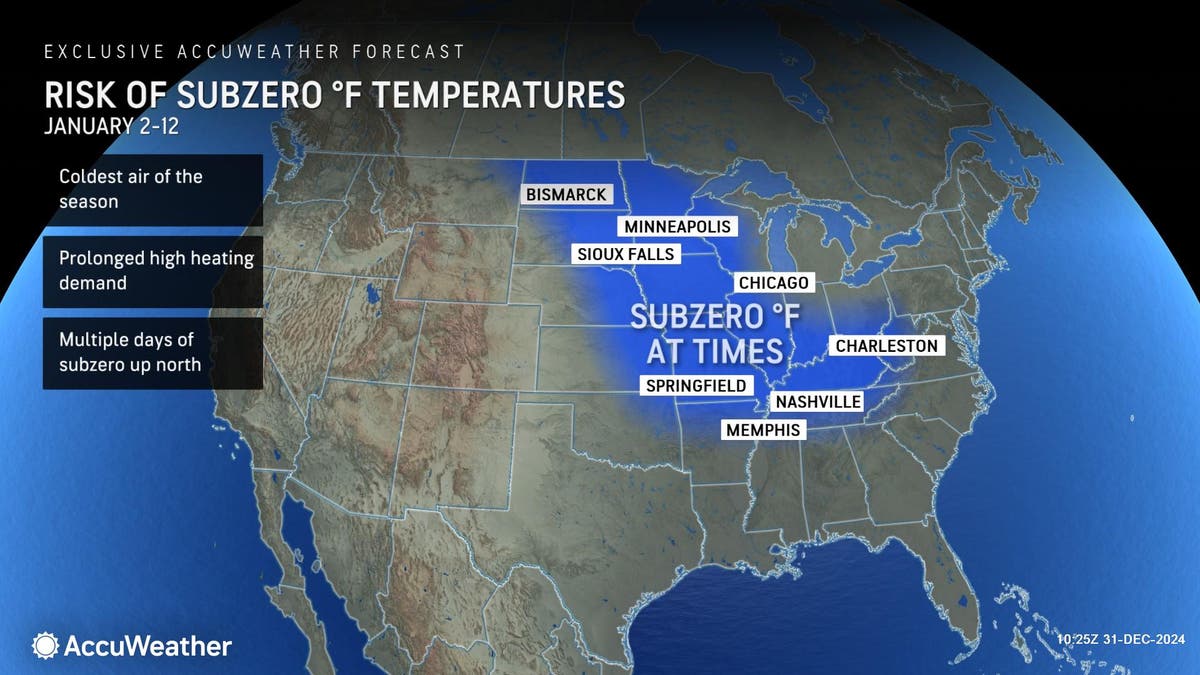The beginning of 2025 will be marked by the year’s first polar vortex, bringing snow, storms, and frigid temperatures that will impact the majority of the country and millions of Americans.
During the year’s second week, the coldest air of the season and dangerous wind chills will affect the Southeast, with below freezing temperatures possible as far south as the Gulf Coast and Florida Peninsula. Frozen precipitation is possible across the region and southern Plains.
Some areas could see temperatures plummet to nearly 30 degrees below average, according to FOX Weather.
open image in galleryA map shows the risk of subzero temperatures across much of the US this week and next. The polar vortex will bring Arctic air across the country (AccuWeather)
The cold may be so extreme that “this could end up being the coldest January since 2011 for the U.S. as a whole,” AccuWeather Lead Long-Range Expert Paul Pastelok said in a statement.
The media forecasting company said that it is expected to create a surge in demand for heating, and warned cold air in the Southeast could result in rolling blackouts and power grid issues.
open image in galleryA man and dog walk on a beach in Hempstead, New York, on Monday. Temperatures will drop quickly across the eastern US (REUTERS/Mike Segar)
“The last two Januarys in the Upper Midwest (Minnesota, Iowa, Wisconsin and Michigan) have been well above the historical average spanning 1991-2020,” AccuWeather Senior Director of Forecasting Operations Dan DePodwin said, “January 2023 was 6.3 Fahrenheit above and January 2024 was 4.2 above. This January will end up below normal in this region for the first time since 2022.”
open image in galleryExtensive cold will grip much of the eastern US, sending temperatures plummeting dozens of degrees below the historical average. The cold could create a surge in demand for heating (AccuWeather)
The Arctic outbreak will spread from the northern Plains to the south and east, with heavy snow expected to fall over the Appalachians, Ohio Valley, Mid-Atlantic, Great Lakes, and Northeast. Forecasters warn snowfall could result in “significant” travel disruptions.
AccuWeather noted that snow could impact major metro areas, including, New York City, Boston, Chicago, Philadelphia, and Washington, DC.
open image in galleryPeople walking over the Brooklyn Bridge in New York City on Monday. New York is one of several major metro areas that could see snowfall next month (REUTERS/Marko Djurica)
Lake effect snow is also likely for areas downwind of the Great Lakes.
This week, as a cooling trend expands eastward, between 6-12 inches are forecast in that region by Thursday morning.
open image in galleryA map shows snowfall this week forecast across the Midwest, Great Lakes, and Northeast. Snow is expected in the Great Lakes region this week (AccuWeather)
While the term “polar vortex” is relatively recent, the phenomenon itself is nothing new. It’s a large region where the atmospheric pressure is lower than its surrounding locations and cold air that surrounds both of the Earth’s poles. It always exists near the poles, but strengthens in the winter.
